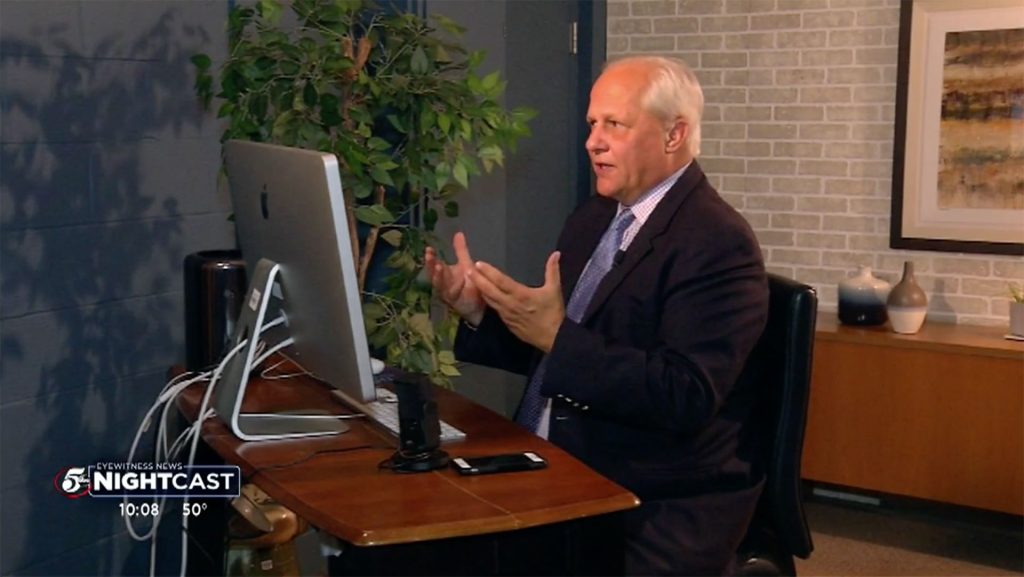
The first thing you notice is the weather. That’s because on KSTP-TV’s Nightcast, it actually is first. Every night, “Forecast First” — there’s no anchor intro, just a meteorologist who pops up out of prime time to do what meteorologists do — appears even before the headlines on the Minneapolis station’s 10 p.m. news program. It’s a familiar segment in an unfamiliar spot and a fitting introduction to a broadcast that’s not afraid to reshuffle the standard formulas. Because what follows is not business as usual, but rather an evolving experiment in reimagining the late news.
KSTP’s bet is that in-depth and investigative reporting, longer stories and interviews, and a focus on issues with broad community impact rather than just the latest “breaking news” will appeal to viewers who already know the day’s headlines and want more substance. Perhaps it will even attract new ones who may have given up on local TV news altogether.
The idea for Nightcast germinated last April, when News Director Kirk Varner and his colleagues considered devoting the entire late news, which was struggling compared to the station’s other newscasts, to the coronavirus pandemic. Instead, they opted for a more permanent transformation. The new format, inspired in part by ABC News Nightline, builds on two of KSTP’s strengths: its seven-person investigative team and its reputation for strong storytelling. “And so the idea was, can we create a broadcast that would really speak to those strengths and be different, really try to take a different approach to late news, being more thoughtful, not being a slave to story count,” says Varner. After three weeks of rehearsals in what Varner calls a “working lab,” the new program premiered on May 5, barreling right into the May book.

Each weeknight broadcast starts (after “Forecast First,” of course) with what the producers call the “front end” — a slickly edited set of highlights of the stories to come, sometimes as long as 1:30 altogether. Nightcast is built around a signature “cover story,” interviews, and a very small number of other packages produced either by the investigative team or one of three reporters assigned to the program, who also take turns contributing same-day stories when they’re not working on something longer term. “We really wanted to walk away from the idea of ‘If it bleeds, it leads,’” says Varner. “The idea would be: What’s the most interesting thing that’s out there today?”
Routine crimes that might top a conventional newscast — shots fired at a St. Paul police officer, for example, on one of the nights I watched — are relegated to a “what else you need to know today” section, often deep into the program, often just as voice-overs. “There are so many stories on any given night that would normally be a lead or that you’d move a reporter to,” says Nightcast producer Stacey Alletto. “And we have to always ask ourselves, ‘Does this have relevance?’ And that’s probably been one of our biggest challenges: learning how to make those decisions.”

There are long chunks of sound from public officials, experts, and other newsmakers. And perhaps most unusual, Alletto and her fellow broadcast producer Alan Hoglund, who work with the reporters to keep an elaborate calendar of stories in various stages of development, are encouraged to mix up the recipe as each day’s distinctive ingredients dictate — not bake them in by the book. That goes not just for format but for story length. The current record for a single report — by Jay Kolls on police presence in Minneapolis’s so-called “Autonomous Zone” — is 10 minutes. “One of the things we want to keep as part of the soul of Nightcast is that idea that we’re flexible and innovative,” says Varner. “We’re willing to color outside the lines to get a newscast that has something really unique and original to it.”

There are also familiar elements. There’s a warm and fuzzy franchise called “So Minnesota.” The meteorologist (Wren Clair, or Dave Dahl on Fridays) comes back with more details and the 7-day, and there’s an affable sports guy (Joe Schmit) with scores, stories, and a signature kicker called “Nightcap” — TV’s equivalent of a viral video. There’s even a bit of banter with the anchor — anchor, singular. Varner threw out the traditional dual-anchor formula, and now Kevin Doran and Lindsey Brown take turns anchoring most of the program solo, with that night’s partner only showing up to deliver the “what else you need to know” items I mentioned earlier.

“I thought the idea of looking different needed to be more than just cosmetic,” says Varner. “And we thought if we were doing a show that was built around longer-format stories, then could we recast the anchors as being not just people who were reading intros…but also giving them more freedom to ask questions of reporters and weave a show together that was more than just script page, script page, script page.”

So far, the ratings are up slightly month over month and year over year, but it won’t be the relatively rapid ratings success we reported on recently in New York, where the Univision station’s late news went to #1 in Adults 18-49 among all stations, not just Spanish-language, with a similar approach. Varner says his bosses at Hubbard Broadcasting, including his GM Rob Hubbard, understand that this experiment will take time. “The objective now is to market it and put it in front of those people who aren’t necessarily normal loyalists to the television station,” says Varner. “And that’s obviously something you don’t do in a month or two. We’re not in the instant success category. But we are pleased with the growth of the product overall.”
WATCH the 9/29 edition of “Nightcast”
All this raises the question of who benefits most from the formulaic structure of most newscasts. It certainly makes life easier for producers who have to lather, rinse, repeat night after night, but I suspect the regularity is reassuring for viewers too — something steady and familiar in chaotic times. It’s no accident that Varner hasn’t extended his daring experiment to any of his other newscasts throughout the day. Perhaps the boldest aspect of Nightcast is its unpredictability.
Varner is thinking of bringing two more of the station’s frontline anchors into the Nightcast rotation, perhaps even building each night around a specific anchor’s strengths and interests. Nightcast is an exercise in dynamic innovation, driven by conviction and optimism. “There’s a quality over quantity thing here that we think has a real shot of succeeding in the marketplace,” says Varner. “And the more validation and feedback we get on that idea, the more we all feel like, ‘Okay, we’re doing the right thing here.’”